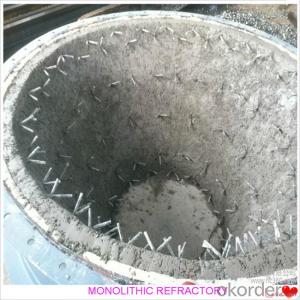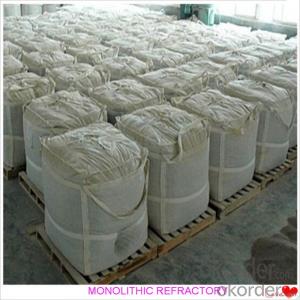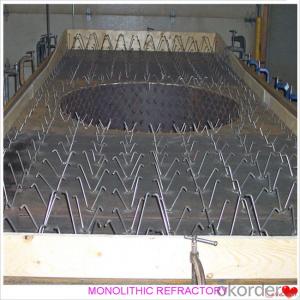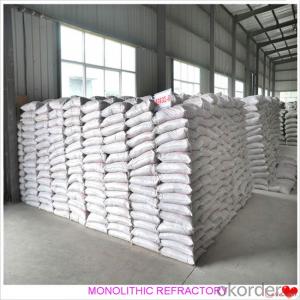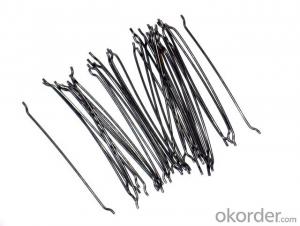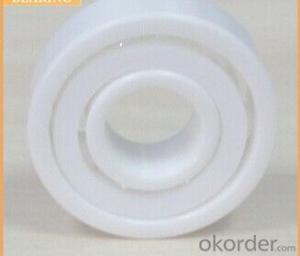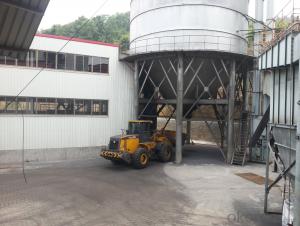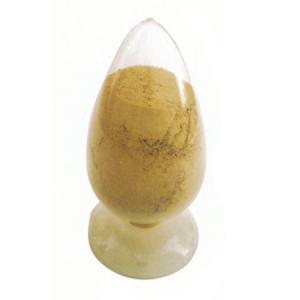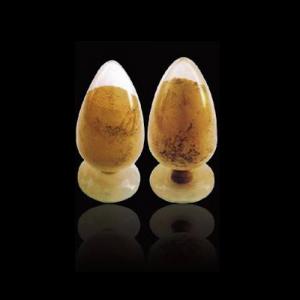Refractory Castable For Fireplace and Industrial Furnace
- Loading Port:
- China main port
- Payment Terms:
- TT or LC
- Min Order Qty:
- 1000 kg
- Supply Capability:
- 3000000 kg/month
OKorder Service Pledge
OKorder Financial Service
You Might Also Like
Refractory Castable for Fireplaces and Industrial Furnaces
Product Description:
Gunning castable is manufactured according to international standards. The product is famous for its excellent abrasion resistance and low thermal conductivity. Further, these can be provided in different specifications as required by clients. Gunning castables use high purity raw materials and additives as the main material, and are made with superfine powder adding technology.
Product Features:
The material has excellent structural stability and air tightness, and has high physical and chemical properties, and also excellent working ability. If should be used with the same material products.
Product Applications:
Widely used in various kiln linings, such as boilers, blast furnace hot blast stoves, heating furnaces, ceramic kilns, heat treatment furnaces, incinerators, re-circulating fluidized bed furnaces and chemical industry and construction industry furnaces.
Product Specifications:
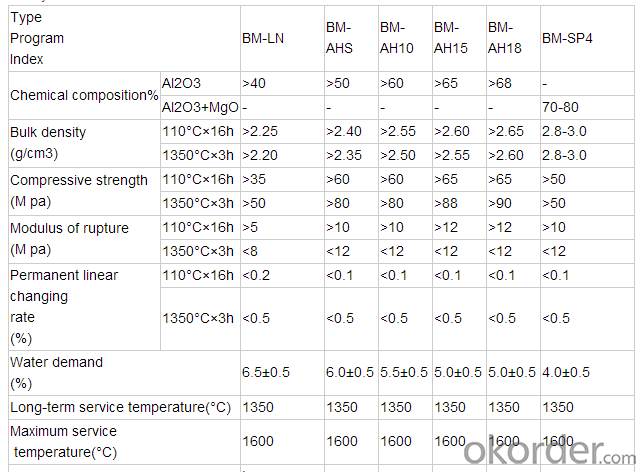
Product Images:
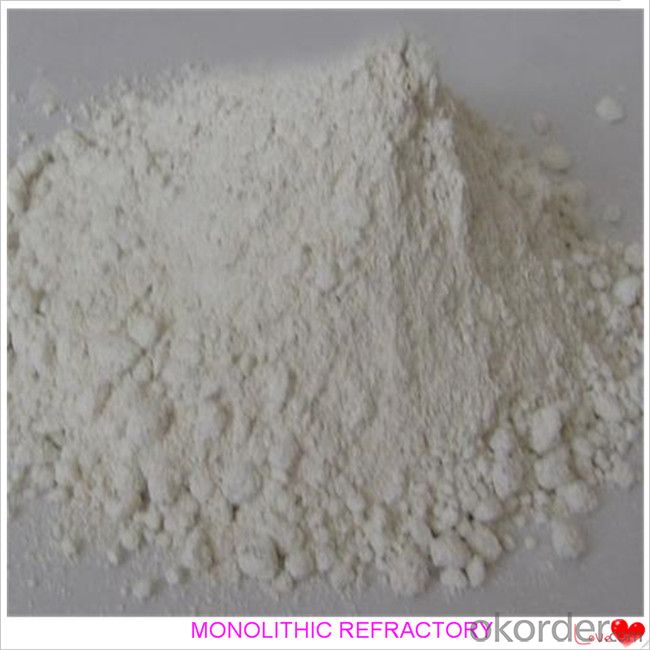
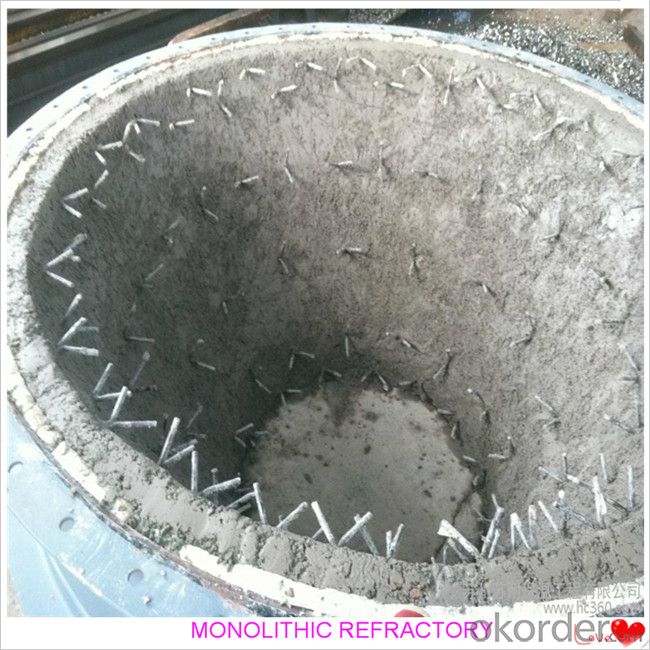
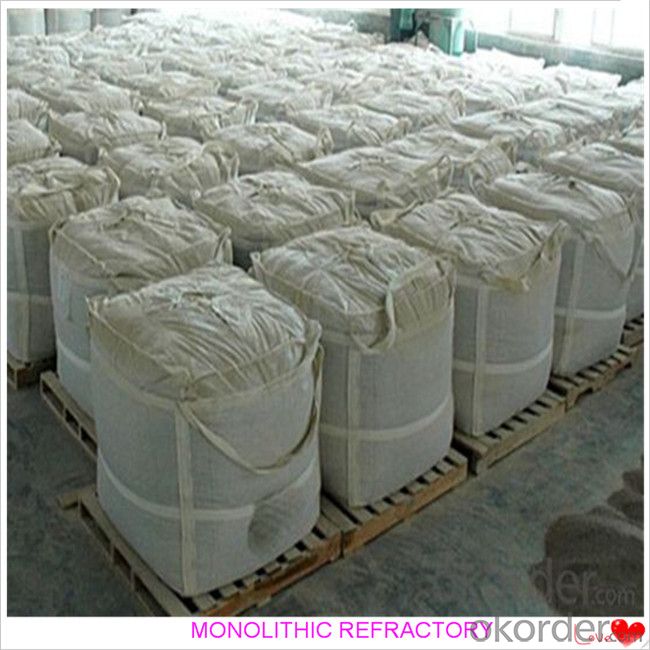
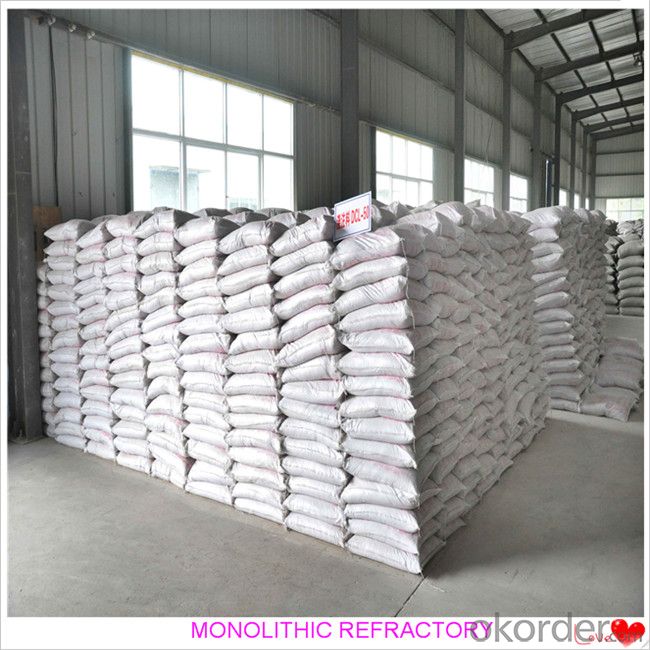
FAQ:
Q1: Why buy Materials & Equipment from OKorder.com?
A1: All products offered by OKorder.com are carefully selected from China's most reliable manufacturing enterprises. Through its ISO certifications, OKorder.com adheres to the highest standards and a commitment to supply chain safety and customer satisfaction.
Q2: How do we guarantee the quality of our products?
A2: We have established an advanced quality management system which conducts strict quality tests at every step, from raw materials to the final product. At the same time, we provide extensive follow-up service assurances as required.
Q3: What are Abrasion Resistant Coatings?
A3: ARC's abrasion resistant coatings guard against the severe wear and erosion that can chip away your plant's bottom line. These high-performance coatings protect new equipment as well as rebuild worn equipment at a fraction of traditional replacement costs.
- Q:How do monolithic refractories perform in aluminum holding furnace applications?
- The use of monolithic refractories in aluminum holding furnace applications has been proven to be highly efficient and effective. These refractories are designed specifically to withstand the extreme temperatures and chemical environments found in these furnaces. One major advantage of monolithic refractories is their ability to create a continuous and seamless lining in the furnace. This eliminates the need for individual bricks or tiles, reducing the risk of thermal shock and cracking. The absence of joints also minimizes the likelihood of molten aluminum leaking through the lining, ensuring better containment and heat retention. Monolithic refractories also provide excellent thermal insulation properties, which are essential in aluminum holding furnaces. They have low thermal conductivity, helping to reduce heat loss and maintain a stable temperature within the furnace. This leads to improved energy efficiency and lower operating costs. Furthermore, monolithic refractories have exceptional resistance to corrosion and chemical attack from molten aluminum and its by-products, such as dross and fluxes. This resistance ensures a longer lifespan for the refractory lining, reducing the need for maintenance and downtime. In addition, monolithic refractories are known for their easy installation and repair. They can be installed quickly and easily, requiring minimal downtime for furnace maintenance. If any localized damage or wear occurs, repairs can be efficiently made by patching or spraying the affected area. In conclusion, monolithic refractories are an excellent choice for aluminum holding furnace applications due to their seamless lining, thermal insulation properties, resistance to corrosion, and easy installation and repair. These refractories significantly enhance the overall performance and efficiency of aluminum holding furnaces.
- Q:What are the main challenges in designing the lining system with monolithic refractories?
- The main challenges in designing the lining system with monolithic refractories include ensuring proper installation and curing, achieving adequate strength and durability, managing thermal expansion and contraction, controlling shrinkage and cracking, and maintaining chemical resistance against corrosive environments. Additionally, the selection of suitable raw materials, proper mixing techniques, and effective installation methods are crucial to overcome these challenges and ensure a successful lining system design.
- Q:How do monolithic refractories provide thermal insulation in the iron and steel industry?
- Monolithic refractories play a crucial role in providing thermal insulation in the iron and steel industry. These refractories are commonly used to line the furnaces and other high-temperature equipment used in the production processes. One way monolithic refractories provide thermal insulation is by their ability to withstand high temperatures without degrading or melting. They are designed to have high heat resistance, which allows them to be used in environments where temperatures can reach several thousand degrees Celsius. By withstanding these extreme temperatures, the refractories prevent the transfer of heat to the surrounding structure, thus providing insulation. Another way monolithic refractories provide thermal insulation is through their low thermal conductivity. These materials have a low thermal conductivity, meaning they are not efficient in conducting heat. Instead, they trap the heat within their structure and minimize its transfer to the surrounding equipment or environment. This characteristic helps to maintain the temperature inside the furnaces and other high-temperature equipment, allowing for efficient and controlled metal production. Furthermore, monolithic refractories can be applied as a thick lining layer, which creates an additional barrier between the high-temperature environment and the surrounding equipment. The thickness of the refractory lining helps to minimize heat transfer and acts as a buffer, reducing the impact of high temperatures on the structural integrity of the equipment. In addition to providing thermal insulation, monolithic refractories also offer excellent resistance to chemical attack and mechanical wear, which are common challenges in the iron and steel industry. This resistance ensures the longevity of the refractory lining, allowing for consistent and reliable insulation over time. Overall, monolithic refractories provide thermal insulation in the iron and steel industry through their high-temperature resistance, low thermal conductivity, thick lining layer, and resistance to chemical attack and mechanical wear. These properties contribute to maintaining the desired temperature inside the equipment and protecting the surrounding structure from the intense heat generated during metal production processes.
- Q:What are the specific requirements of monolithic refractories for continuous casting applications?
- The specific requirements of monolithic refractories for continuous casting applications are designed to withstand the extreme temperatures and thermal shock conditions experienced during the continuous casting process. Firstly, these refractories must have high thermal conductivity to effectively transfer heat away from the molten metal and maintain a stable casting temperature. This helps to prevent the formation of defects such as cracks, hot spots, and uneven solidification in the cast product. Secondly, monolithic refractories for continuous casting applications must have high refractoriness, meaning they can withstand the high temperatures of the molten metal without melting or deforming. This ensures the refractories can provide a protective lining and maintain their structural integrity throughout the casting process. Additionally, these refractories must have excellent resistance to thermal shock. The continuous casting process involves rapid cooling and heating cycles, which can create significant temperature differentials and induce thermal stresses. Monolithic refractories with low thermal expansion and high thermal shock resistance can withstand these conditions without cracking or spalling. Furthermore, good erosion and corrosion resistance are crucial requirements for monolithic refractories in continuous casting applications. The molten metal and slag can be highly corrosive and abrasive, leading to wear and chemical attack on the refractory lining. Hence, refractories with high resistance to erosion and corrosion are essential to ensure the longevity and stability of the lining. Lastly, monolithic refractories for continuous casting applications should have good workability and ease of installation. This allows for efficient and precise lining installation, reducing downtime during maintenance or repairs. Overall, the specific requirements of monolithic refractories for continuous casting applications include high thermal conductivity, refractoriness, thermal shock resistance, erosion and corrosion resistance, as well as good workability. Meeting these requirements ensures the refractories can effectively protect the casting equipment and maintain the quality of the cast products.
- Q:How do monolithic refractories withstand chemical attack from molten metals and slag?
- Due to their unique composition and structure, monolithic refractories exhibit high resistance to chemical attack from molten metals and slag. Unlike refractories with joints or seams, monolithic refractories are made from a single, solid piece, minimizing the chance of chemical penetration. The ability to withstand chemical attack is attributed to several factors. Firstly, monolithic refractories have a high melting point, which surpasses the temperature of the molten substances they encounter. This prevents them from melting or deforming upon contact with hot metals or slag. Additionally, the chemical resistance of monolithic refractories is enhanced by their formulation with materials that possess excellent resistance to chemicals. These materials, such as alumina, magnesia, and zirconia, form stable compounds and have a strong affinity for oxygen. Consequently, when exposed to molten substances, the refractories develop a protective oxide layer on their surface, effectively shielding them from chemical attack. Furthermore, the dense and compact structure of monolithic refractories plays a crucial role in their ability to resist chemical attack. The absence of joints and seams reduces the chances of molten metals and slag infiltrating the refractories and initiating chemical reactions. This dense structure also reduces the porosity of the material, making it less permeable to aggressive substances. Moreover, manufacturers often incorporate specialized additives, such as fibers, binders, and corrosion inhibitors, into monolithic refractories to further enhance their chemical resistance. These additives contribute to the refractories' ability to withstand chemical attack. In conclusion, monolithic refractories are designed to endure chemical attack from molten metals and slag through their high melting point, chemically resistant composition, dense structure, and specialized additives. These properties enable them to maintain their integrity and performance even in the most challenging environments, making them an ideal choice for applications involving high temperatures and corrosive substances.
- Q:How are monolithic refractories repaired or replaced in iron and steel facilities?
- Due to their superior thermal and mechanical properties, monolithic refractories are widely used in iron and steel facilities. These refractories are designed to withstand high temperatures, thermal shocks, and chemical attacks. However, over time, they may experience wear and tear, leading to the need for repair or replacement. The process of repairing or replacing monolithic refractories in iron and steel facilities typically involves the following steps: 1. Inspection: A comprehensive inspection is performed to identify areas that require repair or replacement. This inspection may include visual examination, thermal imaging, or other non-destructive testing techniques to assess the extent of damage. 2. Removal of damaged material: The damaged monolithic refractory material is carefully extracted using appropriate tools and equipment. This step ensures proper adhesion of the new refractory material to the substrate. 3. Surface preparation: The substrate or lining surface is prepared to improve the bonding between the new refractory material and the existing structure. This may involve cleaning, grinding, or shot blasting to remove loose particles, contaminants, and any remaining damaged material. 4. Selection of repair material: Depending on specific requirements and operating conditions, a suitable repair material is chosen. This may involve selecting a similar monolithic refractory material or a specialized repair product designed for the application. 5. Mixing and installation: The repair material is mixed according to the manufacturer's instructions, ensuring the right consistency and workability. It is then applied to the prepared surface using various techniques such as troweling, spraying, or casting. Attention is given to achieve the desired thickness and proper consolidation of the repair material. 6. Curing and drying: After installation, the repaired refractory material is allowed to cure and dry according to the manufacturer's recommendations. This step is crucial to achieve the desired strength and thermal properties of the refractory lining. 7. Quality control: Once the repair or replacement is complete, quality control measures are implemented to ensure the integrity and effectiveness of the repaired or refurbished refractory lining. This may involve conducting tests such as thermal conductivity measurements, density checks, or visual inspections. It is important to note that the process of repairing or replacing monolithic refractories may vary depending on the specific requirements and conditions of each iron and steel facility. Additionally, it is advisable to consult with refractory experts or manufacturers to ensure the correct selection of materials and proper execution of the repair or replacement procedure.
- Q:What are the main factors affecting the erosion resistance of monolithic refractories?
- The erosion resistance of monolithic refractories is influenced by several key factors. These factors include the chemical composition of the refractory material, the microstructure of the material, the temperature and environment in which it is used, and the mechanical properties of the material. The chemical composition of the monolithic refractory plays a crucial role in its erosion resistance. Certain chemical elements and compounds can enhance the resistance of the refractory to erosion, while others may make it more susceptible. For example, the addition of alumina (Al2O3) in the refractory composition can improve its resistance to erosion, as it forms a protective layer on the surface. On the other hand, the presence of impurities or excess amounts of certain elements can weaken the refractory and increase its susceptibility to erosion. The microstructure of the monolithic refractory is another important factor affecting erosion resistance. The refractory's microstructure refers to the arrangement and distribution of its constituent particles. A well-structured microstructure with a uniform distribution of particles can provide better erosion resistance as it ensures a more even distribution of load during exposure to erosive forces. Conversely, a poorly structured microstructure with clusters or weak bonding between particles may lead to localized erosion and failure. The temperature and environment in which the refractory is used also significantly influence erosion resistance. High temperatures can cause thermal stresses, chemical reactions, and phase changes in the refractory material, all of which can affect its erosion resistance. Additionally, the presence of corrosive gases, liquids, or slags can accelerate erosion by promoting chemical reactions or attacking the refractory material, leading to its degradation. Lastly, the mechanical properties of the monolithic refractory, such as its strength, hardness, and toughness, contribute to erosion resistance. A refractory with higher mechanical strength and hardness can withstand erosive forces better than a weaker material. Similarly, a higher toughness helps the refractory resist cracking or spalling when subjected to impact or thermal shock, reducing its vulnerability to erosion. In summary, the erosion resistance of monolithic refractories is influenced by the chemical composition, microstructure, temperature and environment, and mechanical properties of the material. Understanding and optimizing these factors can help in developing refractories with improved erosion resistance for various industrial applications.
- Q:What are the advantages of using monolithic refractories in electric arc furnaces?
- Using monolithic refractories in electric arc furnaces offers several advantages. Firstly, their excellent thermal shock resistance allows them to withstand rapid temperature changes without cracking or deteriorating. This ensures the longevity and efficiency of the furnace. Secondly, monolithic refractories have superior corrosion resistance. They are specifically designed to resist chemical attack from aggressive slag compositions, providing long-lasting protection against corrosion. Additionally, monolithic refractories offer great flexibility in terms of installation. Unlike brick linings, they can be easily applied as a liquid or paste, allowing for faster and more efficient installation. This reduces downtime during maintenance or repairs and allows for customized linings to be easily created. Moreover, monolithic refractories have excellent thermal conductivity, allowing for efficient heat transfer within the furnace. This results in optimal energy use and minimized heat losses, leading to reduced operating costs and increased productivity. Furthermore, monolithic refractories have a high refractoriness, meaning they can withstand extremely high temperatures without deformation or failure. This is crucial for the safe and efficient operation of electric arc furnaces. In conclusion, the advantages of monolithic refractories in electric arc furnaces include their thermal shock resistance, corrosion resistance, ease of installation, high thermal conductivity, and exceptional refractoriness. These properties contribute to improved furnace performance, increased productivity, reduced operating costs, and extended furnace life.
- Q:What are the key factors to consider when designing the lining system with monolithic refractories?
- When designing a lining system with monolithic refractories, there are several key factors that need to be considered. Firstly, the operating conditions of the system need to be thoroughly assessed. Factors such as temperature, pressure, and chemical composition of the materials being processed should be taken into account. This will help determine the appropriate type of monolithic refractories to be used. Secondly, the physical and mechanical properties of the refractories should be considered. These include factors like thermal conductivity, thermal expansion, and mechanical strength. The refractories should have properties that are compatible with the specific requirements of the system to ensure optimal performance and longevity. Thirdly, the installation method and techniques need to be carefully planned. The lining system should be designed in a way that allows for proper installation and ensures a tight seal to prevent any leakage or infiltration. The installation process should also take into account factors like curing time and temperature to ensure the refractories achieve their desired properties. Lastly, the cost and availability of the refractories should be considered. It is important to choose refractories that are cost-effective and readily available in the market. This will help ensure that any maintenance or repairs can be done efficiently without causing significant downtime or additional expenses. By considering these key factors, a well-designed lining system with monolithic refractories can be implemented, providing optimal performance, durability, and cost-effectiveness for the specific application.
- Q:How do monolithic refractories perform in reheating furnace roof applications?
- Monolithic refractories prove highly effective when used on the roofs of reheating furnaces. These refractories are renowned for their outstanding ability to withstand extreme temperature conditions, making them an essential component in furnace operations. Their resistance to thermal shock ensures that they do not crack or spall, guaranteeing the long-lasting durability of the furnace roof. Moreover, monolithic refractories offer exceptional insulation properties, thereby helping to maintain the desired temperature inside the furnace. With their low thermal conductivity, they prevent heat loss and reduce energy consumption. This not only enhances the energy efficiency of the furnace but also leads to cost savings for operators. Furthermore, monolithic refractories provide excellent resistance against chemical attacks from gases and molten metals found within the furnace environment. Designed to withstand corrosive atmospheres, they effectively prevent the penetration of harmful substances, thereby extending the lifespan of the roof refractory. Additionally, monolithic refractories offer easy installation and repair options. Their ability to be cast or gunned in place allows for a seamless and precise application to the roof structure. This feature also facilitates quick and efficient repairs or maintenance, minimizing downtime and production losses. In summary, monolithic refractories are a reliable and efficient choice for reheating furnace roof applications. Their outstanding resistance to thermal shock, insulation properties, chemical resistance, and ease of installation make them the ideal solution for maintaining the structural integrity and performance of the furnace roof.
1. Manufacturer Overview |
|
|---|---|
| Location | |
| Year Established | |
| Annual Output Value | |
| Main Markets | |
| Company Certifications | |
2. Manufacturer Certificates |
|
|---|---|
| a) Certification Name | |
| Range | |
| Reference | |
| Validity Period | |
3. Manufacturer Capability |
|
|---|---|
| a)Trade Capacity | |
| Nearest Port | |
| Export Percentage | |
| No.of Employees in Trade Department | |
| Language Spoken: | |
| b)Factory Information | |
| Factory Size: | |
| No. of Production Lines | |
| Contract Manufacturing | |
| Product Price Range | |
Send your message to us
Refractory Castable For Fireplace and Industrial Furnace
- Loading Port:
- China main port
- Payment Terms:
- TT or LC
- Min Order Qty:
- 1000 kg
- Supply Capability:
- 3000000 kg/month
OKorder Service Pledge
OKorder Financial Service
Similar products
New products
Hot products
Hot Searches
Related keywords

